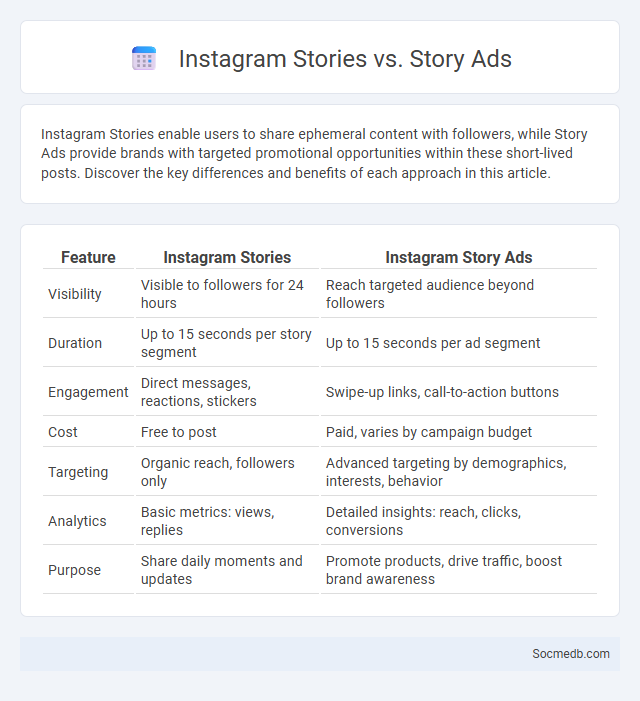
Photo illustration: Instagram Stories vs Story Ads
Instagram Stories enable users to share ephemeral content with followers, while Story Ads provide brands with targeted promotional opportunities within these short-lived posts. Discover the key differences and benefits of each approach in this article.
Table of Comparison
| Feature | Instagram Stories | Instagram Story Ads |
|---|---|---|
| Visibility | Visible to followers for 24 hours | Reach targeted audience beyond followers |
| Duration | Up to 15 seconds per story segment | Up to 15 seconds per ad segment |
| Engagement | Direct messages, reactions, stickers | Swipe-up links, call-to-action buttons |
| Cost | Free to post | Paid, varies by campaign budget |
| Targeting | Organic reach, followers only | Advanced targeting by demographics, interests, behavior |
| Analytics | Basic metrics: views, replies | Detailed insights: reach, clicks, conversions |
| Purpose | Share daily moments and updates | Promote products, drive traffic, boost brand awareness |
Understanding Instagram Stories: Key Features
Instagram Stories enable users to share photos and videos that disappear after 24 hours, offering interactive features like polls, quizzes, and location tags to boost engagement. The Stories format supports creative tools such as stickers, filters, and music integration, enhancing visual storytelling. Instagram's algorithm prioritizes Stories with high viewer interaction, increasing visibility within followers' feeds.
What Are Instagram Story Ads?
Instagram Story Ads are full-screen vertical advertisements displayed within the Stories feature, designed to engage users with immersive, short-form content. These ads can include photos, videos, and interactive elements such as polls, swipe-up links, and call-to-action buttons to drive traffic, increase brand awareness, and boost conversions. Brands leverage Instagram Story Ads to target specific audiences using Facebook's advanced ad targeting tools, optimizing reach and engagement within the active Instagram user base.
Differences Between Instagram Stories and Story Ads
Instagram Stories are temporary posts visible for 24 hours that allow users to share moments, while Story Ads are paid promotional content designed to reach a broader audience beyond your followers. Story Ads integrate seamlessly into the Stories feed but include interactive elements like swipe-up links to drive traffic or conversions. Understanding these differences helps you leverage Instagram Stories for personal engagement and Story Ads for targeted marketing campaigns.
Comparing Stories, Story Ads, and Stories Content
Stories provide immersive, full-screen vertical content designed for quick, engaging consumption, while Story Ads integrate seamlessly within these stories to deliver targeted promotional messages. Compared to regular Stories content, Story Ads feature enhanced call-to-action capabilities and precise audience targeting, maximizing your brand's reach and conversion potential. Understanding these differences helps you optimize engagement strategies by blending organic and paid content effectively within social media platforms.
Organic Engagement with Instagram Stories
Maximize your organic engagement on Instagram Stories by consistently posting interactive content such as polls, quizzes, and question stickers that encourage follower participation. Utilizing features like hashtags, location tags, and mentions can expand your reach and attract a broader audience naturally. Crafting authentic, behind-the-scenes moments helps build trust and keeps your followers invested in your brand's narrative.
Targeting and Reach: Story Ads vs. Stories
Story Ads on social media platforms enable precise targeting based on demographics, interests, and behavior, maximizing ad reach to a defined audience segment. In contrast, organic Stories rely on the follower base and have limited targeting options, often resulting in broader but less focused reach. Combining Story Ads with Stories can optimize social media campaigns by balancing targeted exposure and authentic engagement.
Creative Options: Designing Effective Stories
Creative options for designing effective social media stories include leveraging interactive elements like polls, quizzes, and swipe-up links to boost engagement and drive user action. Utilizing dynamic visuals, such as animations, GIFs, and video clips, enhances storytelling by capturing attention and conveying messages succinctly. Strategic use of brand colors, consistent fonts, and concise captions ensures stories remain visually cohesive and impactful across platforms like Instagram, Facebook, and Snapchat.
Analytics and Performance Metrics
Social media analytics provide critical insights into audience behavior, engagement rates, and content reach, enabling you to optimize your marketing strategy effectively. Performance metrics such as click-through rates, conversion rates, and follower growth offer measurable data to track campaign success and ROI. Leveraging these analytics tools helps maximize your social media impact by making data-driven decisions tailored to your brand's goals.
Best Practices for Brands: Stories vs. Story Ads
Stories engage your audience through authentic, time-sensitive content that enhances brand personality and builds trust. Story ads, designed with clear calls-to-action, deliver targeted messages that drive conversions and measurable results. Leveraging both formats strategically maximizes reach and strengthens Your brand's presence on platforms like Instagram and Facebook.
Choosing the Right Strategy: Stories, Story Ads, or Both
Selecting the optimal social media strategy involves evaluating the unique benefits of Stories and Story Ads to maximize engagement and reach. Stories offer authentic, ephemeral content that fosters direct interaction, while Story Ads provide targeted exposure with precise audience segmentation and measurable ROI. Integrating both formats can enhance brand visibility and drive conversions through a balanced mix of organic interaction and paid promotion.
 socmedb.com
socmedb.com